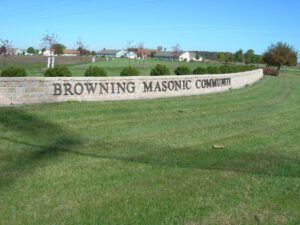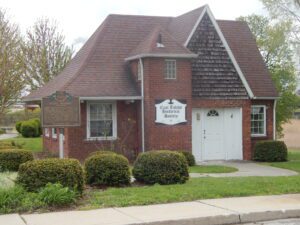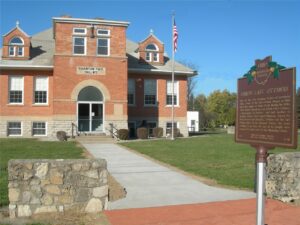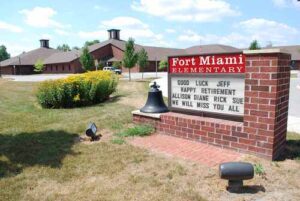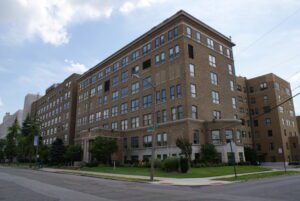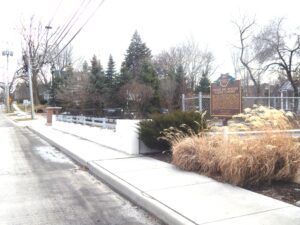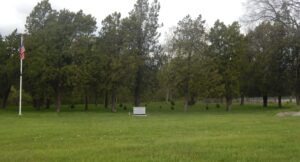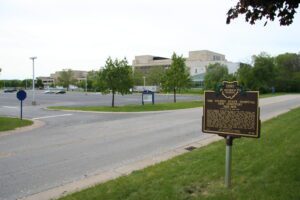, OH
This location was selected in 1936 for a Memorial Home for aged Masons, at the wishes of Otis Avery Browning. Browning, a prominent Toledo businessman, book publisher, civic leader, and Mason, set forth the plans for this Home in a will he prepared in 1922, creating a trust for the Otis Avery Browning Masonic Memorial Fund. His will states, “It is one of the chief purposes of my will, that I may become an instrument, under God’s directing care, in providing for the erection and maintenance of a home for aged people, where they may be properly cared for and with all modern comforts.”
, OH
Considered the first citizen of the East Side, Peter Navarre, along with his brother Robert, first settled the land east of the Maumee River in 1807. A fur trader by profession, Navarre was experienced in wilderness survival and had a deep understanding of Native American life. He died on March 20, 1874, and was buried at Mt. Carmel Cemetery across the river from his beloved East Toledo. In 1922, the City of Toledo declared September 9th Peter Navarre Day, an official city holiday. This marker commemorates the 200th anniversary of the founding of East Toledo.
, OH
Here in the Oak Openings Region of northwest Ohio, some of the last Ottawa villages in Ohio lined the banks of Swan Creek during the 1830s. These Native Americans were led by Chief Ottokee (Autokee), a descendant of Pontiac, and half brother to another Ottawa Chief named Wauseon. Known for being honest and friendly, Ottokee was the last Ottawa chief in the Maumee Valley, for years refusing to go when the last of his people were removed to lands west of the Mississippi River.
, OH
For nearly a century, this 98-acre site was occupied by an orphanage that, over the years, cared for several thousand destitute children. Founded in nearby Toledo in 1867 as the Protestant Orphan’s Home, the orphanage became the Lucas County Children’s Home shortly after it was relocated to this former farmland in 1887. It was renamed the Miami Children’s Center in 1960 before closing permanently in 1986. The main campus, across the River Road, was sold for residential use. The playground, on this side of the road, originally connected to the main campus by a tunnel, was given to the Maumee school system in 2004 as the site for the current Ft. Miami Elementary School. On these grounds, the laughter of a new generation of children at play is being heard once more….a fitting tribute to the disadvantaged boys and girls who formerly lived here.
, OH
In late 1911, the Right Reverend Joseph Schrembs, Toledo’s first Bishop, corresponded with Sister Mary Bernardine McMullen and two companions, Sister Mary Anthony McMullen and Sister Mary DeChantel Lyons, and asked them to come to Toledo to establish the second of three Catholic hospitals in the new diocese. Land was purchased in 1916 on the corner of Madison Avenue and 23rd Street to build what would become a seven-story hospital. Noted Chicago architect, Meyer J. Sturm, was hired to design and construct the hospital using up-to-date methods of hospital construction. Costing approximately $300,000, Mercy Hospital of Toledo was completed in 1918. Bishop Schrembs dedicated and blessed the hospital on June 21 in a grand ceremony involving clergy of the diocese and the Mercy Hospital Guild as guests of honor.
, OH
Sylvania was once the headquarters for the Toledo and Western Railway, an electric interurban line that provided service between Toledo and Pioneer with a branch line to Adrian, Michigan. Construction began here in 1900 with planning and specifications set to steam railroad standards. With completion of rails, a powerhouse, maintenance facilities, and offices, the Toledo and Western Railway Company was soon in the business of providing freight and passenger service and was especially competitive as it owned more freight engines than most interurban lines. Operating an electric interurban line also meant that the company had the ability to provide electricity to people living in Sylvania and to other communities and property owners living along the line’s right-of-way. Besides freight, passengers, and electricity, Toledo and Western also provided postal service, one of the first interurban lines to do so. [continued on other side]
, OH
Toledo State Hospital opened in January 1888 as the Toledo Asylum for the Insane. Originally located immediately south of this cemetery, the hospital was designed to function as a self-contained community for 650 people. Patients lived in large cottages, surrounded by a post office, church, library, male and female hospital, strong wards, bakery, and dining hall. People were admitted with mild to severe forms of mental illness, and a variety of other disabling conditions, including developmental, medical or neurological, as well as for addictions, injuries, and old age. Work became a form of treatment, with patients involved in construction, farming, laundry, and other jobs to help maintain the hospital. Patients could also participate in recreational activities from gardening to playing in the hospital band. The State Hospital became home for many, as hospitalization could last a lifetime, often spanning decades. (continued on other side)
, OH
Toledo State Hospital opened in January 1888 as the Toledo Asylum for the Insane. People were admitted with mild to severe forms of mental illness, and a variety of developmental, medical and neurological conditions, as well as for addictions, injuries, and old age. Originally built to house 650 people, by the 1950s its campus had grown to accommodate over 3,000. Growing access to new medications and treatments then began a gradual decline in patient population. Eventually, most of the buildings were razed, and much of the hospital’s property was transferred, later becoming the site of The Medical College of Ohio. This transfer included the two Toledo State Hospital cemeteries, with documented burials (as of 2009) totaling 1,994 persons. Toledo State Hospital New Cemetery was opened in 1922, when the Old Cemetery (1888-1922), located .5 miles to the northeast, reached capacity. (continued on other side)


